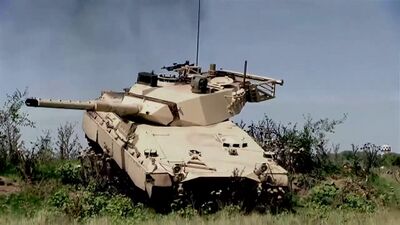Mangusta Main Battle Tank
| Mangusta | |
|---|---|
 | |
| Type | Tank |
| Place of origin | |
| Service history | |
| In service | 1977 - |
| Used by | Lumenic Army |
| Production history | |
| Manufacturer | Amante S.p.A |
| Specifications | |
| Weight | 30.5 t (30.0 long tons; 33.6 short tons) |
| Length | 6.75 m (22 ft 2 in) |
| Width | 3.25 m (10 ft 8 in) |
| Height | 2.42 m (7 ft 11 in) |
| Crew | 4 |
| Armor | Protection from up to 20 mm projectiles along the frontal arc, 35 mm of all around armor protection for the turret. |
Main armament | 1 x Munizioni Reali CT-105/77 105 mm cannon |
Secondary armament | 1 x MGMAC 50 7.5x54 mm coaxial machine gun MLMAC 52 12.7x99 mm machine gun mounted on the turret roof |
| Engine | MDVL 833-V6 diesel engine |
| Suspension | Torsion-bar |
Operational range | 590 km (370 mi), 800 km (500 mi) with auxiliary fuel tanks |
| Speed | 75 km/h (47 mph) |
The Mangusta Main Battle Tank is a light main battle tank designed and produced by Amante S.p.A of Luminerra to replace the Toro Main Battle Tank, which had entered service in 1951. The Mangusta was designed with speed and mobility in mind, with the intent to allow it to outmaneuver Soviet Order forces and place killing shots into the volunerable sides and rear of enemy armored vehicles using its 105 mm cannon, which was also utilized on the Toro C, as well as a newly designed 105 mm gun launched anti-tank guided missile.
Generally considered a failure, the Mangusta was generally unsuccessful at outmaneuvering Soviet forces and was unable to survive hits from any vehicle currently in service with the Soviet Order forces. This resulted in most Lumenic armored units being withdrawn from front line service and being employed in anti-partisan operations behind the main line of advance. The vehicle was quickly withdrawn from service following the development of the Decurion main battle tank, which entered service in 1995, with the last Mangusta being withdrawn from service in March of 1999.
History and design
Operational history
The Mangusta met the Lumenic Army's stated requirement for a lightweight and fast tank with a low silhouette and sufficient firepower to defeat contemporary armored threats. The Mangusta was able to defeat Soviet armor with its main armament when it was able to obtains hots against the sides and rear of Soviet vehicles, and was also able to penetrate and destroy Soviet armor with frontal attacks using its gun-launched anti-tank guided missile. However, it was generally deemed a failure by the Lumenic Legion and was unpopular with armored crews due to its deficient protection, with crews noting that the vehicle could be penetrated by event light anti-armor weapons deployed by the Soviet Order. Further,which it was able to destroy lighter Soviet Order vehicles, such as the BMP series, it was as vulnerable to counterfire from those vehicles.
Variants
- Mangusta: Initial production version
- Mangusta B: Upgrade package introduced in the mid 1980's
- Mangusta C: Features the new Munizioni Reali CT-120/86 in addition to electronics and sensors upgrades first announced in 1989. This vehicle was never accepted into service.
